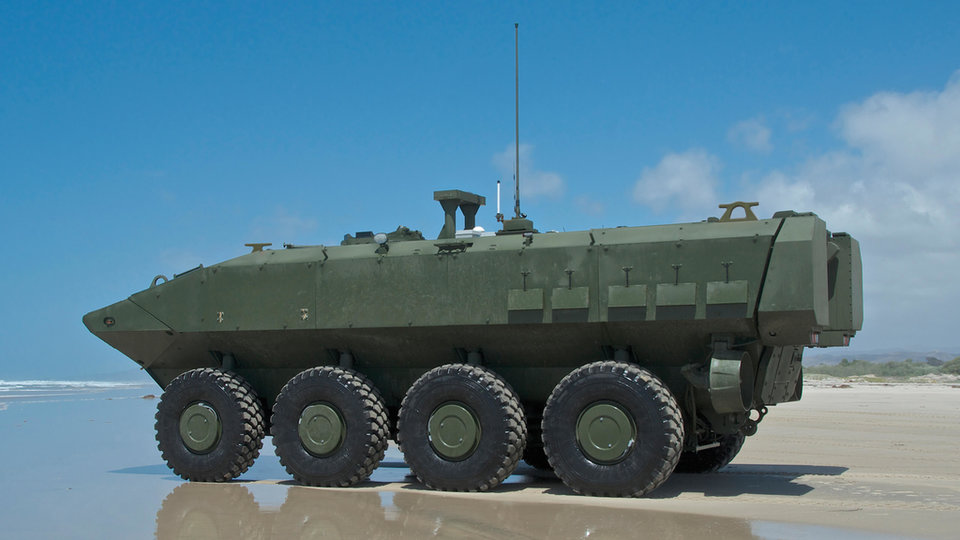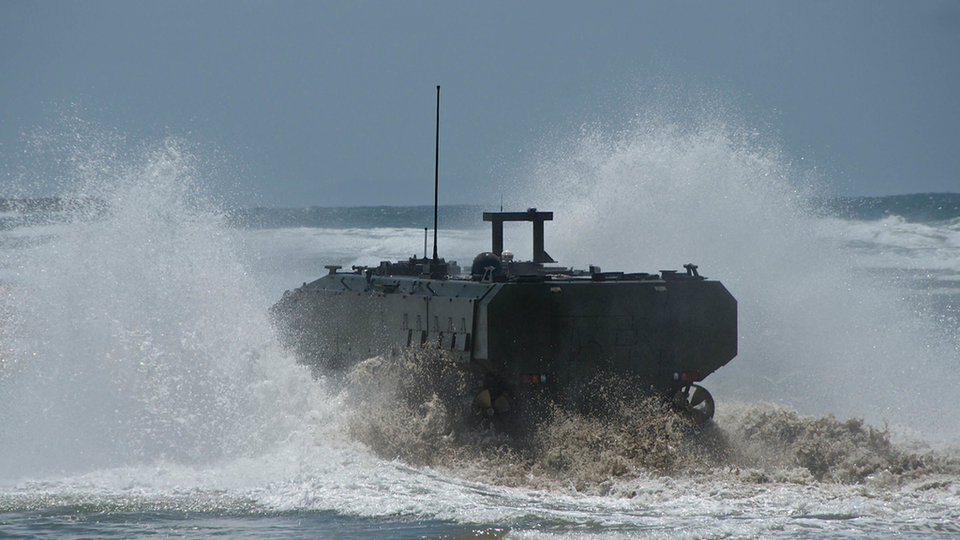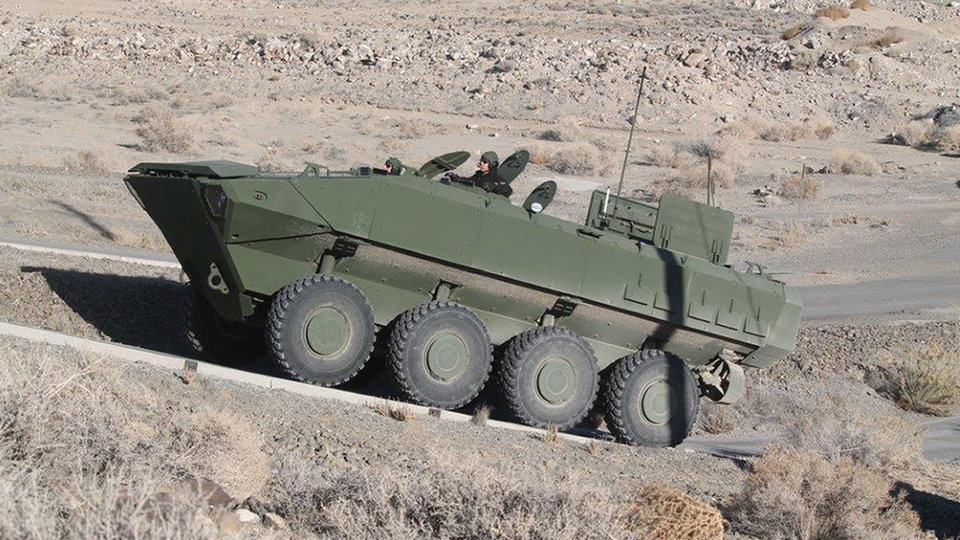Land
New kid on the dock: US Marine Corps amphibious vehicle rolls ashore
In June, the US Marine Corps (USMC) awarded BAE Systems a $198m contract to build 30 Amphibious Combat Vehicles (ACV) on a low-rate production basis. Berenice Baker takes a look at the eight-wheeled platform designed to replace the venerable Assault Amphibious Vehicle (AAV), which has been in service since 1972 and repeatedly upgraded.
/ Image courtesy of US Marine Corps
There comes a time when an old friend becomes too high-maintenance. The AAV is a veteran of the Falklands War, the invasion of Grenada and the Gulf War, among others, and in its time has been fitted with new engines, weapons systems and armour that added so much weight it needed a new bow plane kit to stay afloat.
Replacement parts are no longer manufactured, making ongoing upkeep prohibitively expensive, and it does not offer the required level of protection against the improvised explosive device (IED) threat that the Marines face in modern combat environments.
The search was on, as combat vehicle chief information officer at Marine Corps Combat Development Command (MCCDC) Kurt Koch explains. “Since 2014, the Marine Corps has systematically worked toward a replacement for the AAV through the ACV programme,” says Koch. “The programme is phased and incremented in order to rapidly develop and replace the legacy system with a modern assault amphibian.”
From SuperAV to ACV: the long journey to a replacement
The winning ACV contender started life as the SuperAV developed by Italian manufacturer Iveco Defence Vehicles. The company partnered with BAE Systems in 2011 to offer it to the US Marine Corps (USMC) for the Marine Personnel Carrier programme, which was put on hold in 2013, and, after a number of fits and starts, was restructured as the ACV programme.
By this time, the companies had carried out a number of alterations to meet the USMC’s requirements and undertaken significant testing, including water and land mobility, ship launch and recovery, and survivability. It also completed several sea demonstrations, including operating in Sea State 3 conditions.
After the USMC issued a request for proposal for the first phase and increment of the ACV programme (ACV 1.1) in 2015, BAE Systems and Iveco Defence Vehicles were awarded one of two engineering, manufacturing, and development (EMD) contracts to produce 16 prototype ACV vehicles.
Once handed over to the Marines, extensive testing was conducted at five different locations, including the Amphibious Vehicle Test Branch at Marine Corps Base Camp Pendleton in California. The aim was to determine how it will protect Marines, be easier to maintain, and meet requirements for survivability and reliability.

BAE and Iveco’s Amphibious Combat Vehicle 1.1. Image courtesy of BAE Systems
The Amphibious Combat Vehicle: capabilities for future combat
Explaining which qualities led to its selection, Koch says: “The ACV is a modern eight-wheeled amphibious armoured personnel carrier that will operate effectively in ground combat element-based manoeuvre task forces with an effective balance of performance, protection and payload. The ACV will be fielded to Assault Amphibian Battalions. Those units are tasked with tactically transporting Marine Corps infantry forces and other units of the ground combat element.”
The ACV is equipped with a six-cylinder 700HP Cursor engine made by FPT Industrial and carries a crew of three with 13 embarked Marines, has a blast-resistant V-shaped hull to withstand IED blasts, which together offer MRAP+ survivability. It can be fitted with a remote-controlled heavy cannon.
“The ACV is a modern eight-wheeled amphibious armoured personnel carrier that will operate effectively in ground combat element-based manoeuvre task forces with an effective balance of performance, protection and payload.”
At sea, two counter-rotating propellers deliver 29,000kg of thrust, each taking it to speeds of up to 10km/h with a range of 64km, and it can be launched and recovered from a well deck. On land, while the legacy AAV it is replacing is a tracked vehicle, the eight wheels of the ACV are individually powered, so if any are damaged it can continue to move while delivering better motility on soft sand or soil. It has a range of 523km on land on a single tank of fuel and can travel at speeds of up to 105km/h.
According to Koch, the first phase and increment (ACV 1.1) has been streamlined to achieve an initial operational capability in 2020. “Subsequent increments and phases will expand ACV fielding and introduce additional capabilities and mission role variants such as an ACV optimised for battalion and regimental-level command and control,” he adds.
The first vehicles will begin delivery in autumn 2019, and I Marine Expeditionary Force will be the first to receive the new ACV when fielding starts in the fourth quarter of 2020. Full operational capability is scheduled for 2023. The legacy AAV's service life is planned to end in 2030, and the plan is for the ACV programme to replace the entire fleet in phases.

The ACV is based on Iveco’s SuperAV. Image courtesy of BAE Systems
Renewed interest in amphibious vehicles around the world
Far from being unique to the US Marines, judging by recent defence equipment exhibitions, amphibious vehicles are enjoying a resurgence of interest among armed forces around the world.
At the recent Eurosatory event in Paris, Krauss-Maffei Wegmann unveiled a concept demonstrator for its self-funded Amphibious Protected Vehicle Tracked programme. Adapted from the company’s Puma armoured fighting vehicle, in service with the German Army, the 30-tonne rubber-tracked vehicle is designed for a crew of two with eight embarked personnel.
Unusually, it travels in different directions on water and on land, helpfully labelled for Eurosatory attendees with arrows labelled ‘float’ indicating the pointy end and ‘drive’ towards the chisel-shaped end. The 816hp MTU engine offers a maximum land speed of 70km/h and a maximum range of 550km on land, and an at-sea speed of 13km/h and 54km.
“The ability to project power from ship-to-objective across a wide range of operations remains a viable and valuable capability in the 21st Century.”
Koch explains the ongoing demand for amphibious armoured vehicles, saying: “The ability to project power from ship-to-objective across a wide range of operations remains a viable and valuable capability in the 21st Century. Amphibious operations are being effectively planned, prepared and executed on a routine basis by forward-deployed Marine Expeditionary Units.”
Of course, the Marines don’t operate in a vacuum, and the ability of amphibious vehicles to carry them ashore plays a key role in modern multi-domain warfare.
“Amphibian-borne assault forces possess robust protected mobility upon crossing the surf-line and as such are ideal to facilitate the rapid conduct of manoeuvre and in bringing to bear a range of capabilities beyond the capacity of a force inserted by air,” says Koch. “The combination of surface and air assault forces remains a powerful deterrent and credible threat within the context of a naval campaign.”
With renewed interest and investment, a new generation of amphibious military vehicles is laying down tracks that will be followed for decades to come.
A camp of Rapidly Deployable System buildings taking shape. Image: World Housing Solutions

BAE is building 30 ACVs for the US Marine Corps. Image courtesy of BAE Systems